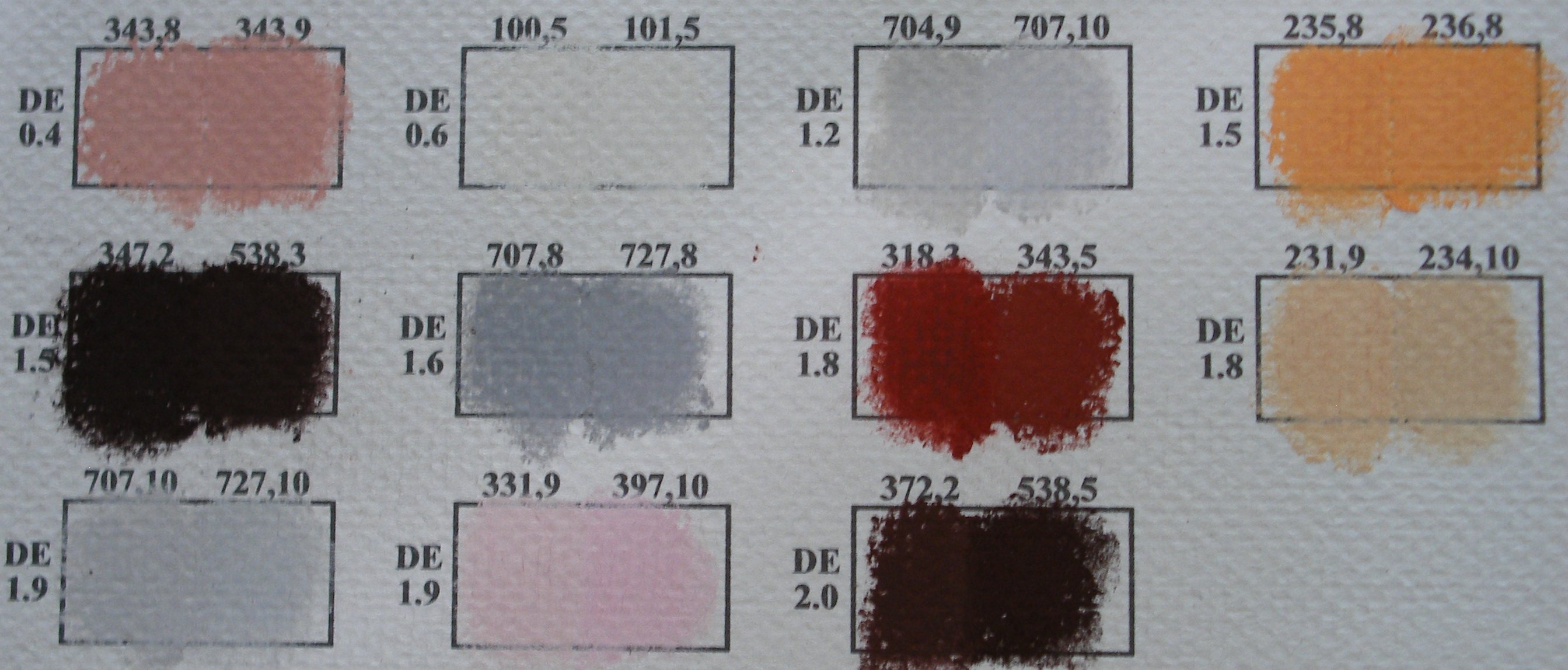
Most pastel manufacturers produce hundreds of pastels, covering a wide variety of
colours. Pastel painters need some way to make sense of such a broad array. One natural
approach, that has been used here, is to organize pastels in terms of
the Munsell system. Munsell
specifications were found for the following pastel sets:
| Brand | Number Of Pastels |
| Great American | 546 |
| Sennelier | 525 |
| Unison | 422 |
| Mount Vision | 407 |
| Schmincke | 400 |
| Blue Earth | 336 |
| Girault | 300 |
| Rembrandt | 218 |
| Total | 3154 |
The first step in finding the Munsell specifications is making samples of the individual pastels. A sample is just a square (about an inch on each side) of colour, in an opaque layer, made by applying a particular pastel to paper; it is the colour a painter will get when he uses that pastel. Here is a sheet of samples of some Rembrandt pastels:

|
The reflectance spectra of the samples are then measured with a spectrophotometer. The picture below shows the X-Rite i1Pro2 spectrophotometer that was used to measure the Rembrandt samples:

|
A pastel's
Munsell specification
can be calculated once the pastel is measured. Such specifications were calculated for all 3154
pastels, and are available in the files
PastelData.xls or PastelData.ods.
The files contain multiple spreadsheets. Here are a few lines from the spreadsheet "Munsell," listing
the pastels of highest chroma. The rest of the spreadsheet lists Munsell data for the
other 3150 pastels.
The measurement project provided some interesting results. For example, some examples were found
in which two pastels with the same name, from the same manufacturer, were slightly, and
occasionally exceptionally, different. Here are two examples:

|

|
| Two Versions of Rembrandt 331,9 | Two Versions of Sennelier 303 |

|
| Some Duplicates in Rembrandt Pastels |
Currently, this analysis has only been applied to the eight brands listed. It would be desirable for painters to extend this analysis to other pastel brands, to give more comprehensive results, and comparisons between manufacturers. The current bottleneck is obtaining samples. While the author owns several hundred pastels from many brands, he has no complete line from any one brand. Other pastel artists, who do have complete sets, are invited to contribute to further pastel analysis by sending the author samples, which he can measure and analyze.
The samples should meet the following conditions:
1. Each sample should be at least half an inch (or 1.5 centimeters) by half an inch,
2. The samples should be applied to a standard pastel paper. White Canson Mi-Teintes paper
is adequate, but sanded papers, such as Wallis or Sennelier LaCarte, work well, too,
3. The pastels should be applied thickly enough that the samples are opaque. When in doubt,
add more pastel to a sample. Ideally, it should be impossible to discern the colour of
the paper through the pastel sample,
4. The surface of the samples should be reasonably smooth, with no obvious irregularities.
Rubbing the pastel with a finger produces a sufficient finish,
5. The samples should be clearly labelled, using the pastel manufacturer's naming convention,
6. Do not use any fixative, as this can alter colours. A protective sheet of Glassine can
be used over each sheet of samples, to keep the pastel from rubbing off, and
7. There is no problem using a large number of smaller sheets (say 8.5 by 11 inches), for
easier shipping.
Once the samples are prepared, they can be mailed to the author, Paul Centore, at 62 Chicago Ave., Groton, Connecticut 06340, USA, who will measure them and post results on his website. Artists should be aware that preparing samples can be considerably more time-consuming and tedious than it seems, especially since it is important to produce a thick, opaque layer. An entire set of samples can take eight hours or more, depending on the number of pastels.
Apart from artists, pastel manufacturers are also invited to send samples of their lines. If the preparation process is too tedious, then the manufacturer can send a complete set of pastels to the author, who will prepare the samples himself, and generate a report. In addition to providing some exposure, the report might also be helpful at identifying unexpected duplicates, or gaps in gamut coverage, that can be used for revision and development of the pastel line.